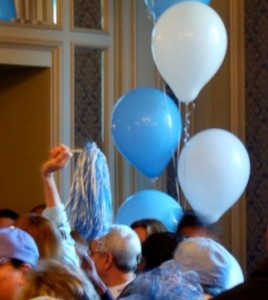 It’s no secret that the most important thing about major gift fundraising is relationship building. No matter whether you’re talking about raising money from individuals, companies, or foundations, the key is building honest, authentic relationships to bring about positive change. [Read more…]
It’s no secret that the most important thing about major gift fundraising is relationship building. No matter whether you’re talking about raising money from individuals, companies, or foundations, the key is building honest, authentic relationships to bring about positive change. [Read more…]
Going beyond capacity ratings
 In case you missed it (and click here if you did), last week on this blog Melissa Bank Stepno shared her knowledge and some wise words from her colleague, David Lamb, on capacity ratings.
In case you missed it (and click here if you did), last week on this blog Melissa Bank Stepno shared her knowledge and some wise words from her colleague, David Lamb, on capacity ratings.
Capacity ratings are an important factor in every major gift effort. They will not be perfect, (let me repeat that – they will never be perfect) and capacity rating are just one of several data points we use, but they are an important tool to help us rank our very top prospects.
One of the common misconceptions of capacity codes is that some folks new to the profession might think that capacity means “How much will they give us?” It doesn’t.
A capacity rating says, “what is this person’s total ‘wallet’ for philanthropic giving in a year to every organization they support?” [Read more…]
The Fair, the handwriting analysis booth, and relationship management
 When I was a kid, we went to the Bloomsburg Fair every year, rain or shine. The Fair has been a magical place for generations of kids (no matter their age) and a place of hope as well. It’s been held in late September since 1855, and hundreds of thousands of people come every year for miles around, making it the biggest fair in the Commonwealth of Pennsylvania.
When I was a kid, we went to the Bloomsburg Fair every year, rain or shine. The Fair has been a magical place for generations of kids (no matter their age) and a place of hope as well. It’s been held in late September since 1855, and hundreds of thousands of people come every year for miles around, making it the biggest fair in the Commonwealth of Pennsylvania.
It’s an agricultural/exhibit fair, and my mom tells me that during the Great Depression, many folks relied (some fairly desperately) on winning cash prizes for things they grew, bottled, jarred, knitted, sewed and showed at the Fair. Slightly more recently, the Bloomsburg Fair was the place where Taylor Swift made her concert debut. So I suppose it’s always been a place where dreams (and money) are made.
Every year as we [Read more…]
Ratings – Measuring inclination
Ratings – The Myth of 5% Over Five
 We’ve been dead wrong in our calculations of gift potential for major donors.
We’ve been dead wrong in our calculations of gift potential for major donors.
We don’t have the right information. And we’re using what we do have the wrong way.
Let me set the stage: normally when we’re calculating a major donor’s capacity to give we look at their total visible assets and calculate that they will give 5% of that over five years to charity. Where does that ratio come from? The IRS, the Chronicle of Philanthropy and Giving USA are the three big resources for philanthropic giving information in the US.
The 5% figure we’ve been using isn’t real
3 Daring Relationship Management Solutions
I was recently asked by a client if there were a few simple things I could recommend that would help them re-energize their prospect management system – even if it meant they had to do something scary and daring. Sometimes just making a change of any kind can be daring, but we usually only regret the things we don’t do in life, not the things we try to do to improve things. I hope these 3 ideas give you something to dare to do in the new year!
The Conundrum: strategy paralysis
My client had a lot of prospects that were in the discovery stage – those still to be met for the first time. It was a great problem to have, but it was creating systemic paralysis – who should they see first?
The Solution: un-frieze the system
Each of these new prospects was not equal in his or her capacity to give or in their feelings of affinity to the organization. Leadership was shy of doing an electronic screening because the last one had just sat on the shelf and so they felt it was a waste of money. We helped our client re-screen the group and verified the results for them. Together we set up a rating system and ranked each of the new prospects. The fundraisers could then start from the top and work their way down the list.
The Conundrum: cultivating overly fertile fields
In addition to all of those great newly-ranked prospects, there were prospects who had been in our client’s relationship management system for at least 2 years with no forward progress. These constituents were being invited to dinners, lunches, and other events but they had not converted as major donors. Leadership was starting to ask the chief fundraiser questions about justifying the expense of all of these activities.
The Solution: some fields just need to lay fallow for awhile
Although changing out portfolios is hard, we can’t keep cultivating people forever, especially if there are higher-rated prospects waiting in the discovery stage. We recommended that our client switch any prospects who had been in the system for over 2 years without progress to a new prospect manager for 6 months to see if someone else would have better luck. If there was still no forward progress, these non-donors needed to be moved out of the major donor portfolios to make way for better prospects.
A larger organization might be able to move these prospects into actively-cultivated annual fund officer portfolios.
The Conundrum: moving targets
As we looked deeper in our client’s relationship management system, they asked for an idea of how many cultivation moves each fundraiser should realistically be expected to do per month.
The Solution: targeting moves
Since this was a relatively young program, we suggested a goal of 2 completed moves per day. Each month, fundraisers would have a result of 40 moves, and should be able to have at least one meaningful contact with everyone in their portfolio every quarter. The result would be 480 great moves per fundraiser for the year.
To recap, three quick and daring solutions to improve your prospect management system:
- Prioritize and make a plan to involve the best brand-new prospects
- Keep the pipeline filled with people who want to be there
- Set a daily goal for prospect moves and watch annual totals beat expectations
12 Great Ideas for Prospect Research in 2013
Resolving to make better use of prospect research in 2013 – or just interested in some new ideas for the coming year? Here are some suggestions to inspire you!
Are your organization’s fundraisers taking trips to warmer climes for events and meetings with snowbirds next month? Now’s a good time to do some simple data mining to find great prospects for fill-in visits while there.
February
Now is a good time to do an electronic screening of some or all of your organization’s new donors from the previous year. Which ones have the most potential to be major donor prospects? Develop a strategy to engage newly identified prospects by May.
March
What did your fundraising division do exceptionally well in 2012? Where do you need to do some work? Use analytics in-house, or have an independent audit done to measure last year’s fundraising/research performance. Set targets for using research throughout the year based on the priorities and needs you identify.
April
Tax season is here! Which of your prospects have giftable stock options? Several free and fee-based sources allow you to create alerts to keep current throughout the year on directors and executives of public companies who are required to report their stock and options holdings and sales.
May
 Take a lesson from political fundraising: Targeted emails based on click-throughs and web usage have meant huge gains in involvement and donations during the last two presidential campaign cycles. Can you use market research techniques for prospect research purposes to discover what your annual fund donors are specifically interested in supporting?
Take a lesson from political fundraising: Targeted emails based on click-throughs and web usage have meant huge gains in involvement and donations during the last two presidential campaign cycles. Can you use market research techniques for prospect research purposes to discover what your annual fund donors are specifically interested in supporting?
June
For many educational organizations, June is the time to research parents of incoming students. How well do your data transfer systems integrate for ease of access to allowed information? Do you have a plan to manage this time-sensitive research? Create a process document for this important activity so that your best practices are repeated every year.
This is the month to declare independence from all of the prospects in your tracking system that have not budged (despite your best efforts) on the pipeline in the past year. All of the great new prospects you identified back in February should now be in your relationship management system. Draw up plans for new ways to engage them in the fall.
August
The beautiful waterfront of Baltimore, Maryland will be the location for the annual conference of the Association of Professional Researchers for Advancement on August 7-10. The APRA conference is the place to be for prospect researchers and front-line fundraisers who want to learn cutting edge techniques and resources. Come prepared to learn – this is a no-fluff conference, and every aspect of research is covered, from the ABC’s through complex algorithms.
September
Back to school means making sure you have up-to-date information on your very top prospects, and on all of the new prospects you’ve identified over the year. Get ready now for those year-end solicitations so you’re not faced with a December research profile queue crush.
October
Find creative ways to use social media and relationship mapping to identify potential board members and other top volunteers. Who amongst your constituents have high Klout scores? Which ones are hubs on a relationship map? Find and use tools that help you pinpoint influencers who can be advocates and help you engage with a new circle of donors.
Does your organization put on a lot of events this time of year? If event briefings are part of the research priorities that you set back in March, now may be the time to update your event briefing template(s) and policies for information access – not overload. Plan now so that the right people are getting the right amount of information on time and within budget.
December
Before you renew research subscriptions for the coming year, take a look at the fundraising operating plan and talk with colleagues about priorities ahead. Will the chief fundraising officer be traveling internationally to meet with donors? Maybe it’s time to look into international research resources, training, or outsourcing options. Are you about to launch a campaign? You might need to budget for screenings or analytics now.
What resources will you need to be successful next year? Great success with prospect research is all about being prepared. Happy New Year!




